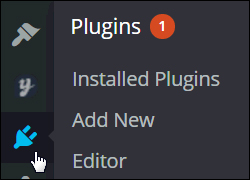 In a separate blog post, we provide a detailed explanation of what WP plugins are all about and how you can use plugins to extend your site’s functionality.
In a separate blog post, we provide a detailed explanation of what WP plugins are all about and how you can use plugins to extend your site’s functionality.
To read the article, go here:
In this step-by-step tutorial you will learn the importance of keeping all WordPress plugins up-to-date, how to easily upgrade and remove your WordPress plugins, and discover practical plugin management tips.
How To Update And Delete WordPress Plugins
Why Plugins Need To Be Updated
WordPress regularly updates its software (about every 3-4 months) to fix bugs and address security issues and vulnerabilities found in older software versions, as well as to improve existing features.
Depending on how many plugins you have installed on your site, there will typically be new updates for plugins whenever WordPress distributes an updated version.
This is because most plugins for WordPress are created by third-party developers, so sometimes code in the new WordPress version conflicts with plugins that were developed for a previous version. When this happens, there is a potential for problems to sometimes develop.
Fortunately, most WordPress plugin developers (and the WordPress developer community itself) are fairly proactive when it comes to making sure that plugins get updated when a new version of WordPress is released (if updating is required). All you have to do as a website owner, is just maintain your plugins up-to-date, which, as you will soon learn, is very simple, quick and easy to do.
![]()
Keeping your WordPress plugins up-to-date and deleting old plugins you no longer use is an essential aspect of good WordPress management and helps to avoid problems or errors.
The step-by-step tutorial below explains how to update and delete plugins safely in WordPress without editing web code.
How To Update And Delete WordPress Plugins Safely From The WordPress Admin Dashboard – Step-By-Step Tutorial
WordPress has a few methods to notify you when plugins need updating.
For example, you can immediately see how many plugins are out-of-date as soon as you log into your Administration panel by looking at the “Plugins” menu.
For example, in the screenshot below, you can see that 9 WP plugins have older versions that need updating …
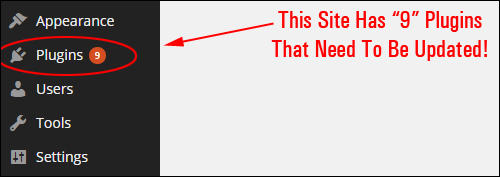
You can also check how many plugins need updating from your WP Notification Toolbar (as shown below, several plugins should be brought up to date) …
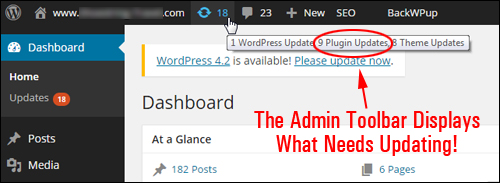
The Plugins screen (Plugins > Installed Plugins) also lets you know which plugins need updating …
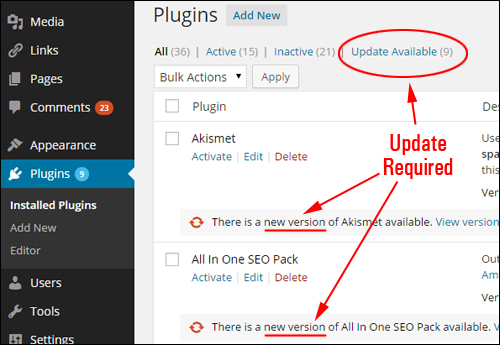
As well as providing information about which plugins have available updates, the Plugins page provides links to the plugin developer pages and gives you the option to update your plugin individually or in bulk …
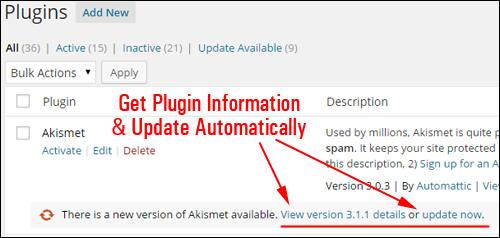
Let’s start by showing you how to upgrade one plugin at a time.
How To Update Plugins One At A Time
![]()
Always make a backup of your site files and database before making any updates to your website or blog.
In your main menu, go to Plugins > Installed Plugins …
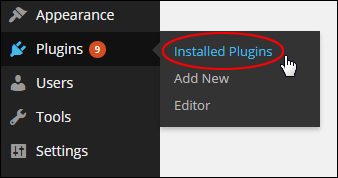
The “Plugins” section will display in your browser. This table of plugins can be quite long depending on how many plugins you have installed on your site …
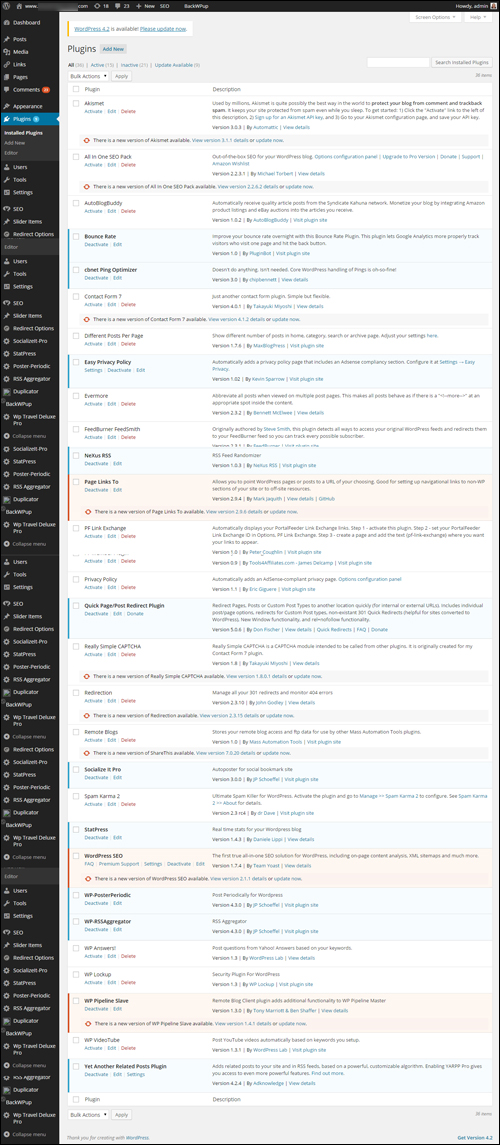
(WordPress Plugins Page)
![]()
Tips:
If you have too many plugins and would like to reduce the number of plugins showing on the page, then click on the Screen Options tab at the top of your Plugins area and enter a smaller number of items per page (all plugins show on the page by default), then click the ‘Apply’ button …

Your Plugins area will now be made more manageable with a pagination feature added. You can find an installed plugin by scrolling through the pages or using the “Search Installed Plugins” function …
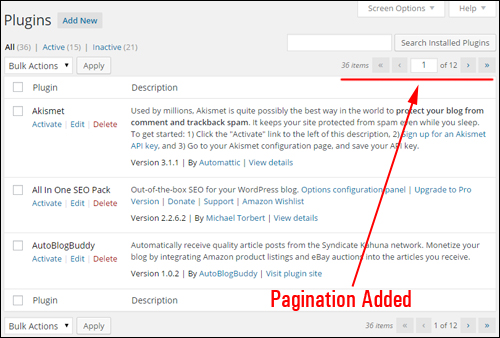
WordPress displays plugin information in different color backgrounds depending on the status of the plugins (active vs. inactive and outdated vs up-to-date) …
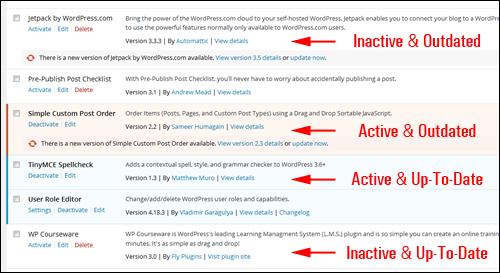
Plugins that need upgrading have a distinctive notification message: “There is a new version of [Plugin Name] available” …

Select the plugin that needs to be updated and click on the update now link …

WordPress provides simple plugin updating, so that the process of updating your plugins takes place with just “one click” without leaving your Plugins area …
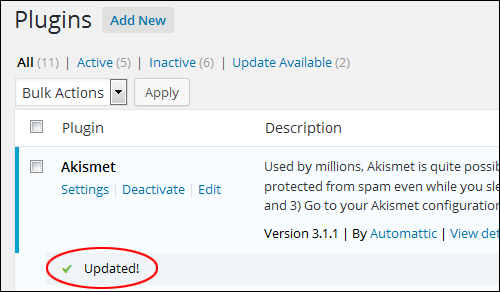
Repeat the above process for any other plugins on your site that need updating, or refer to the section below if you have many plugins that are out-of-date and would like to upgrade all plugins at once.
***
Now that you know how to update WordPress plugins one at a time, let’s show you how to update multiple plugins simultaneously.
How To Bulk-Upgrade WP Plugins
To upgrade multiple WP plugins in a single operation from your admin area, go to the “Plugins” area and click on the Update Available link on the menu at the top of the page …

Tick the checkbox next to the Plugin column header to select all plugins at once, or select each plugin you want to upgrade by checking their individual boxes …
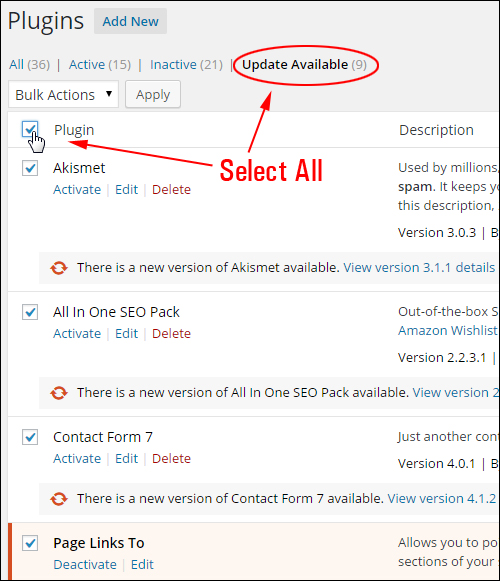
In the Bulk Actions pull-down menu at the top of the page, choose Update …
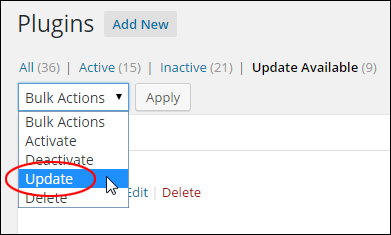
And then click Apply …
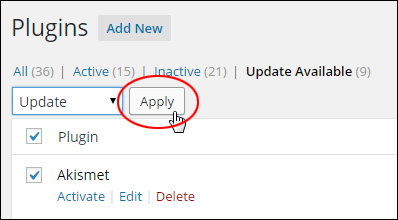
Your selected plugins will begin the update process …
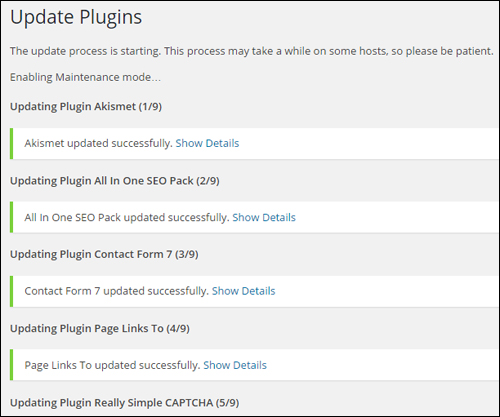
After all plugin updates are completed, you can click on the Return to Plugins page link to go back to your Plugins screen, or visit another section of your dashboard …
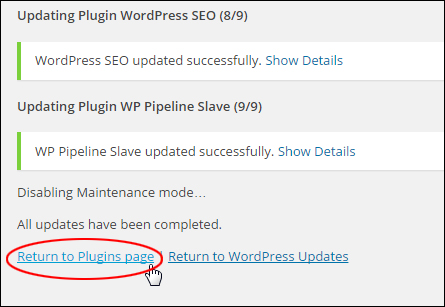
Once your plugins are all up-to-date, the plugin notifications will disappear (i.e. the “at-a-glance” indicators and “There is a new version of XYZ plugin available” notices no longer display on your screen, toolbar and menus) …
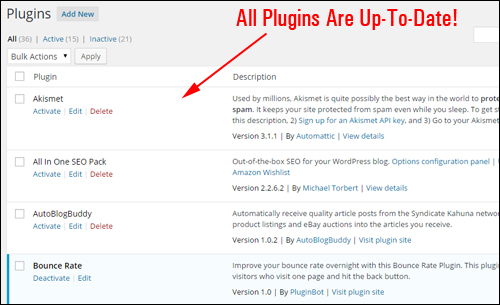
You have updated all plugins on your site!
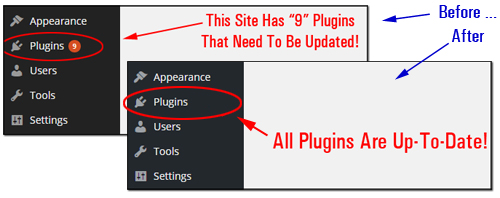
(When your site uses the latest version of all plugins, the notification icons do not display)
Now that you know how to automatically update your inside your dashboard, it’s time to learn how to safely delete plugins from your WordPress blog or website.
Deleting WP Plugins
It’s a good idea to uninstall plugins that you no longer need or are no longer using on your site. This conserves resource usage and also eliminate problems.
In this section, we show you how to safely delete unused plugins from your WordPress site.
![]()
Always create a full back up of your site before installing, upgrading or deleting plugins, in case something goes wrong and you need to recover data or restore your site.
To delete a plugin, go to your admin menu and click on Plugins > Installed Plugins …
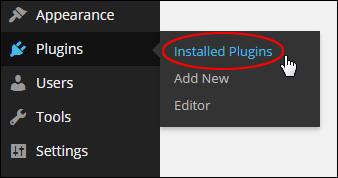
In the Plugins page, locate the plugin you want to delete and make sure it is deactivated.
Hint: Inactive plugins have a different colored background than active plugins and display an “Activate” link below the plugin name …
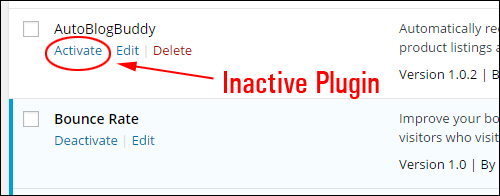
If the plugin is active, then click on Deactivate before continuing with your plugin deletion …

Next, click Delete …

If you need to review a list of all the files that will be deleted before going ahead, then click on the “Click to view entire list of files which will be deleted” link in the “Delete Plugin” page …
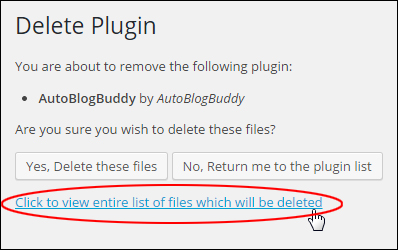
All files belonging to the plugin selected for deletionwill be listed on your screen …
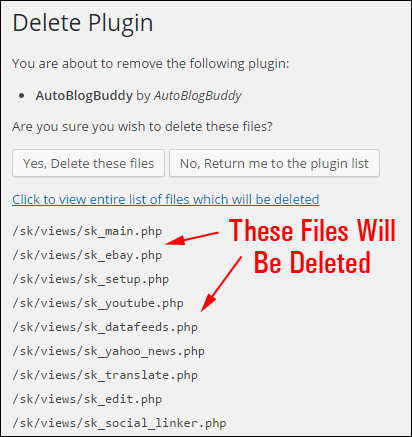
If you are certain that you want to proceed and delete the selected plugin files, then click on the Yes, Delete these files button …
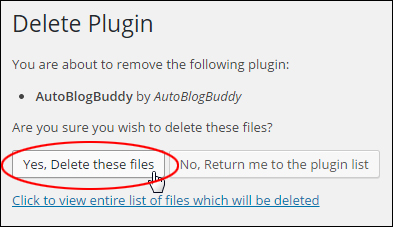
Your plugins and related files will be removed from your WordPress installation …
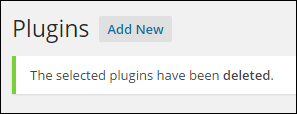
How To Bulk-Delete Plugins
You can delete all inactive plugins at once, or select a combination of active and inactive plugins to be deleted.
![]()
Note: To delete any plugins that are presently active, you first need to deactivate them.
Go to the “Plugins” section and select all of the active plugins that you want to delete by either placing a tick next to their check box, or selecting the checkbox next to the Plugin column header to select all plugins (warning: this will deactivate all plugins) …
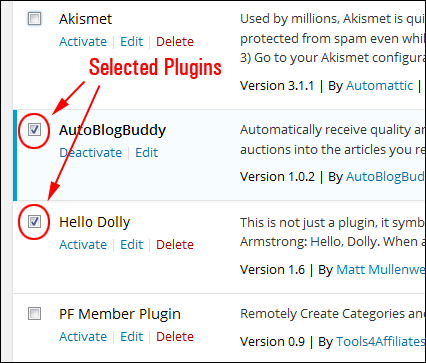
Next, specify Deactivate from the Bulk Actions pull-down menu …
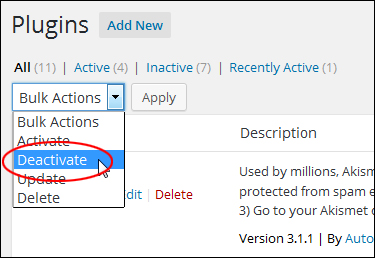
Click the Apply button …
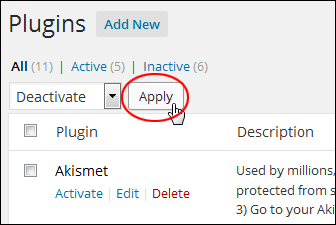
All selected plugins will be deactivated …
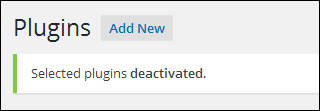
Once you have deactivated these plugins, click on the Inactive link on the menu at the top of the page …
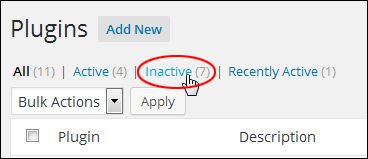
Click the check box in the Plugin column header to select all plugins at once, or select each plugin you want to remove by checking their individual boxes …
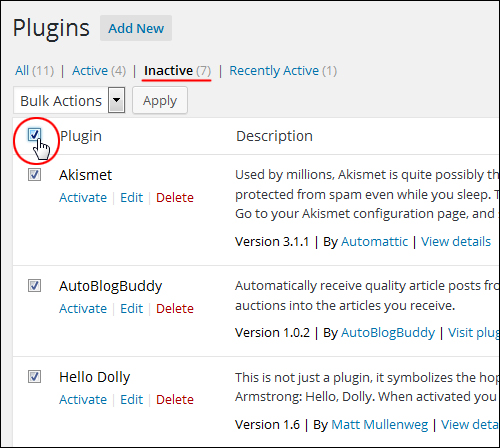
Once you have selected all the plugins that you want deleted, specify Delete from the Bulk Actions drop-down menu …
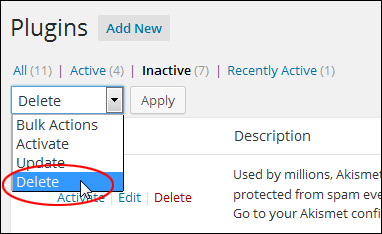
Click the Apply button …
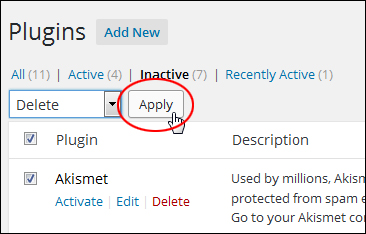
A list of all selected plugins will show up in the Delete Plugins area. Click on “click to view entire list of files which will be deleted” to review all the plugin files that you are about to delete, or click on the Yes, Delete these files button if you are sure that you would like to go ahead and delete all of the selected plugins …
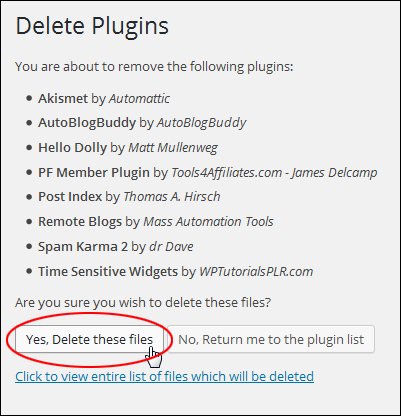
All plugins will be deleted …
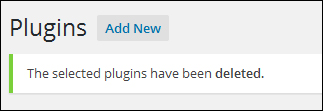
Managing WordPress Plugins – WordPress Tools
As well as the methods shown above, you can use a number of 3rd-party tools to manage your WordPress plugins.
Health Check & troubleshooting

This plugin provides comprehensive checks for your WordPress installation to detect common configuration errors and known issues. It also enables plugins and themes to add their own custom checks.
The debug section allows you to easily gather information about your WordPress and server configuration, which can be shared with support representatives for themes, plugins, or on the official WordPress.org support forums.
The troubleshooting feature allows you to initiate a clean WordPress session, where all plugins are disabled and a default theme is used, but only for your user account until you choose to disable it or log out.
The Tools section offers the ability to check for file tampering in WordPress, test email-sending functionality, and verify plugin compatibility with future PHP version updates.
For more details, go here: Health Check And Troubleshooting
Managing WordPress Plugins On Multiple Sites
As discussed earlier, when plugin updates are released, the best practice is to update the plugin as soon as possible to its latest version.
What if you run multiple WordPress sites using the same plugin?
Typically, you would need to log in to every site individually and update the plugin manually from the site’s admin dashboard.
If you manage or plan to manage multiple sites, this process can become very time-consuming, especially as plugins get updated quite often.
If you manage multiple WordPress sites, you can install, update, and delete multiple plugins on all your sites automatically and simultaneously using WordPress site management tools, like the one below:
WPMU DEV’s The Hub

The Hub lets you manage unlimited WordPress sites easily and effectively from one central command center.
The Updates section of The Hub shows you exactly what needs updating on each of your managed site(s), including plugins, themes, and core software updates.

The Hub’s Updates features display how many outdated components need updating on your site(s).
You can choose to either update all your plugins at once or update them individually with just a few clicks. Best of all, you don’t need to log into every site separately to perform your plugin updates.

Update everything at once or perform individual updates directly in The Hub with a few clicks.
This can be a real time-saver when managing multiple WordPress sites, especially when WordPress releases a new version and you have to update many plugins and themes to prevent potential issues from happening.

You can read our comprehensive article on managing multiple sites effectively using the Hub or visit WPMU DEV to learn more and try The Hub for free.
***
"Wow! I never knew there's so much to learn about WordPress! I bought one of the WordPress for Dummies three years ago, such authors need to be on this course!" - Rich Law, Create A Blog Now